University Finance Report: Managing Resources and Decisions
VerifiedAdded on 2020/06/06
|16
|5641
|46
Report
AI Summary
This report delves into the critical aspects of financial resource management and decision-making within a business context. It begins by identifying and analyzing various sources of finance, categorizing them based on time period (long-term and short-term) and assessing their implications. The report then evaluates the appropriateness of different financing options, considering factors like owner's capital, loans, debtors, and leasing, while also examining the associated costs. Financial planning is highlighted as a key element, emphasizing its significance in identifying investment opportunities and preventing financial shortages. Furthermore, the report explores the information required by decision-makers, including financial statements and the impact of financing decisions on these statements. It also covers techniques like budgeting and unit price calculations to aid in decision-making and introduces investment appraisal techniques for project evaluation. The report concludes with an analysis of financial statements, including those of different organizations, and their interpretation using financial ratios.
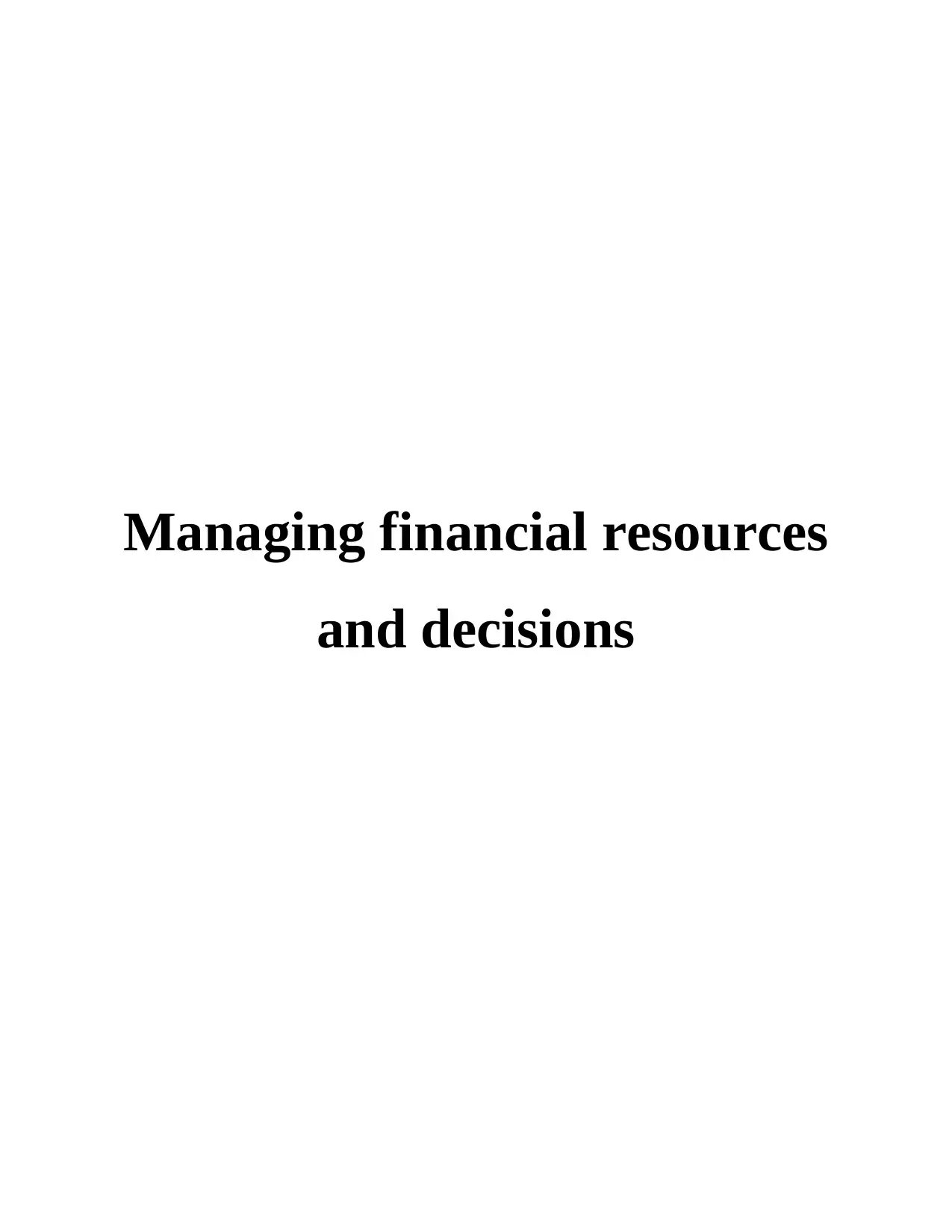
Managing financial resources
and decisions
and decisions
Paraphrase This Document
Need a fresh take? Get an instant paraphrase of this document with our AI Paraphraser
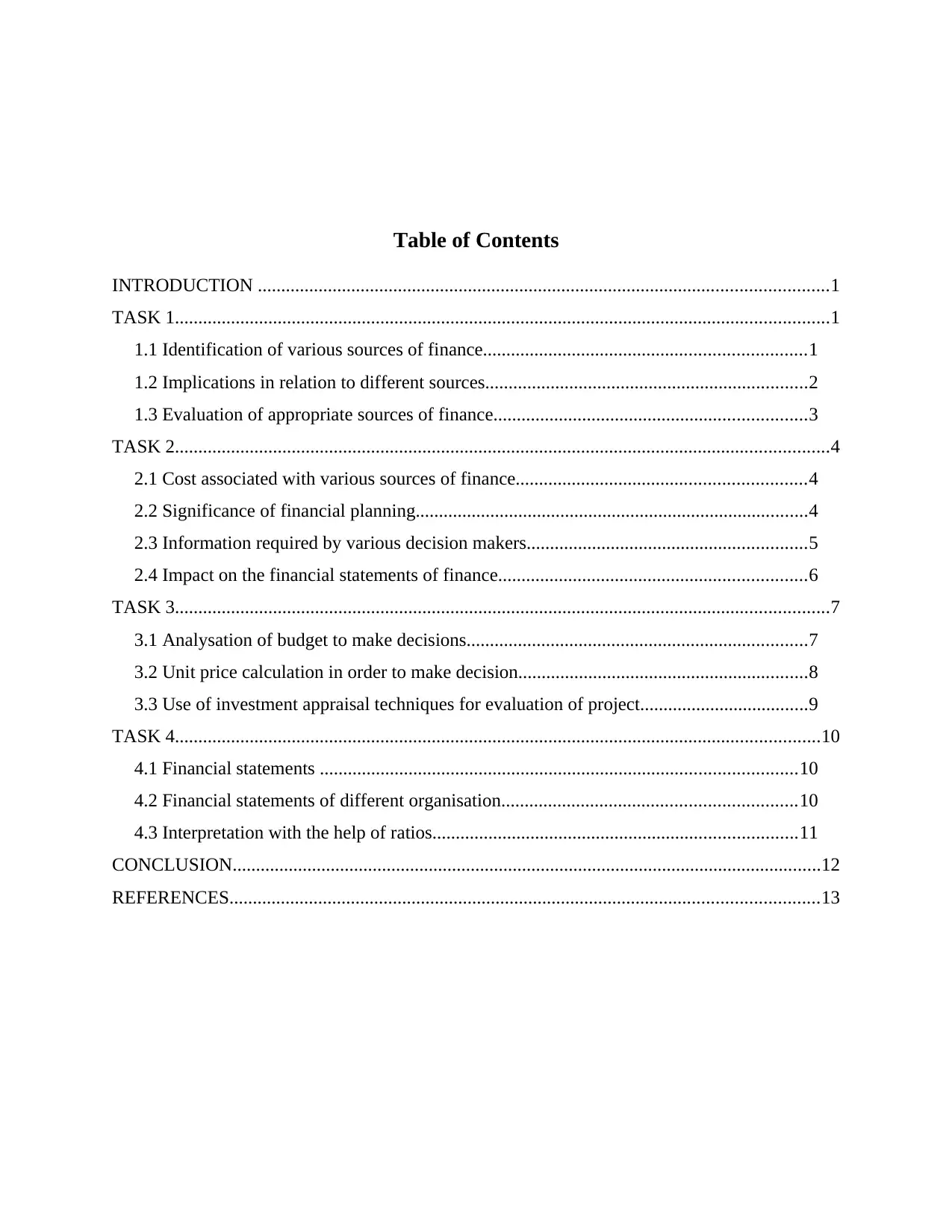
Table of Contents
INTRODUCTION ..........................................................................................................................1
TASK 1............................................................................................................................................1
1.1 Identification of various sources of finance.....................................................................1
1.2 Implications in relation to different sources.....................................................................2
1.3 Evaluation of appropriate sources of finance...................................................................3
TASK 2............................................................................................................................................4
2.1 Cost associated with various sources of finance..............................................................4
2.2 Significance of financial planning....................................................................................4
2.3 Information required by various decision makers............................................................5
2.4 Impact on the financial statements of finance..................................................................6
TASK 3............................................................................................................................................7
3.1 Analysation of budget to make decisions.........................................................................7
3.2 Unit price calculation in order to make decision..............................................................8
3.3 Use of investment appraisal techniques for evaluation of project....................................9
TASK 4..........................................................................................................................................10
4.1 Financial statements ......................................................................................................10
4.2 Financial statements of different organisation...............................................................10
4.3 Interpretation with the help of ratios..............................................................................11
CONCLUSION..............................................................................................................................12
REFERENCES..............................................................................................................................13
INTRODUCTION ..........................................................................................................................1
TASK 1............................................................................................................................................1
1.1 Identification of various sources of finance.....................................................................1
1.2 Implications in relation to different sources.....................................................................2
1.3 Evaluation of appropriate sources of finance...................................................................3
TASK 2............................................................................................................................................4
2.1 Cost associated with various sources of finance..............................................................4
2.2 Significance of financial planning....................................................................................4
2.3 Information required by various decision makers............................................................5
2.4 Impact on the financial statements of finance..................................................................6
TASK 3............................................................................................................................................7
3.1 Analysation of budget to make decisions.........................................................................7
3.2 Unit price calculation in order to make decision..............................................................8
3.3 Use of investment appraisal techniques for evaluation of project....................................9
TASK 4..........................................................................................................................................10
4.1 Financial statements ......................................................................................................10
4.2 Financial statements of different organisation...............................................................10
4.3 Interpretation with the help of ratios..............................................................................11
CONCLUSION..............................................................................................................................12
REFERENCES..............................................................................................................................13
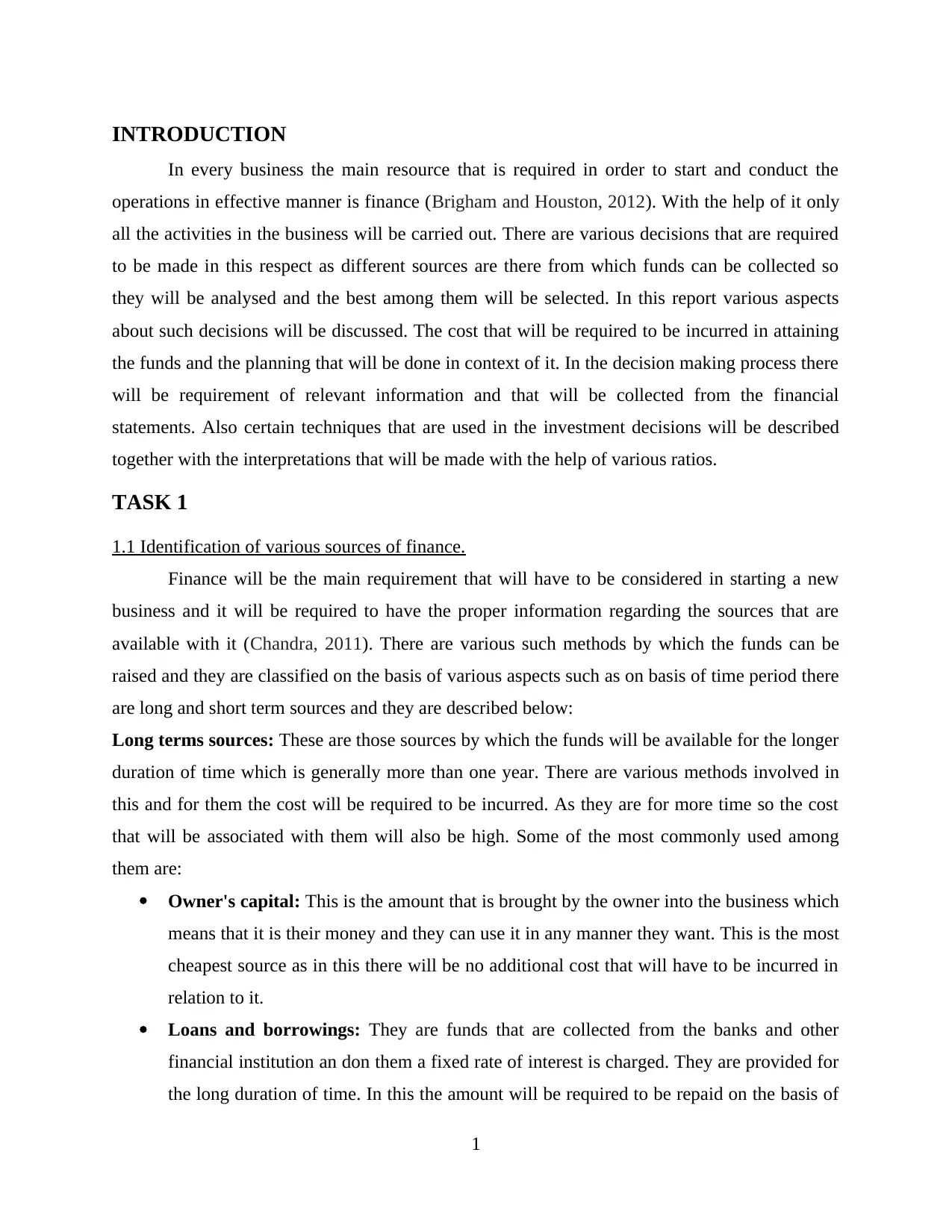
INTRODUCTION
In every business the main resource that is required in order to start and conduct the
operations in effective manner is finance (Brigham and Houston, 2012). With the help of it only
all the activities in the business will be carried out. There are various decisions that are required
to be made in this respect as different sources are there from which funds can be collected so
they will be analysed and the best among them will be selected. In this report various aspects
about such decisions will be discussed. The cost that will be required to be incurred in attaining
the funds and the planning that will be done in context of it. In the decision making process there
will be requirement of relevant information and that will be collected from the financial
statements. Also certain techniques that are used in the investment decisions will be described
together with the interpretations that will be made with the help of various ratios.
TASK 1
1.1 Identification of various sources of finance.
Finance will be the main requirement that will have to be considered in starting a new
business and it will be required to have the proper information regarding the sources that are
available with it (Chandra, 2011). There are various such methods by which the funds can be
raised and they are classified on the basis of various aspects such as on basis of time period there
are long and short term sources and they are described below:
Long terms sources: These are those sources by which the funds will be available for the longer
duration of time which is generally more than one year. There are various methods involved in
this and for them the cost will be required to be incurred. As they are for more time so the cost
that will be associated with them will also be high. Some of the most commonly used among
them are:
Owner's capital: This is the amount that is brought by the owner into the business which
means that it is their money and they can use it in any manner they want. This is the most
cheapest source as in this there will be no additional cost that will have to be incurred in
relation to it.
Loans and borrowings: They are funds that are collected from the banks and other
financial institution an don them a fixed rate of interest is charged. They are provided for
the long duration of time. In this the amount will be required to be repaid on the basis of
1
In every business the main resource that is required in order to start and conduct the
operations in effective manner is finance (Brigham and Houston, 2012). With the help of it only
all the activities in the business will be carried out. There are various decisions that are required
to be made in this respect as different sources are there from which funds can be collected so
they will be analysed and the best among them will be selected. In this report various aspects
about such decisions will be discussed. The cost that will be required to be incurred in attaining
the funds and the planning that will be done in context of it. In the decision making process there
will be requirement of relevant information and that will be collected from the financial
statements. Also certain techniques that are used in the investment decisions will be described
together with the interpretations that will be made with the help of various ratios.
TASK 1
1.1 Identification of various sources of finance.
Finance will be the main requirement that will have to be considered in starting a new
business and it will be required to have the proper information regarding the sources that are
available with it (Chandra, 2011). There are various such methods by which the funds can be
raised and they are classified on the basis of various aspects such as on basis of time period there
are long and short term sources and they are described below:
Long terms sources: These are those sources by which the funds will be available for the longer
duration of time which is generally more than one year. There are various methods involved in
this and for them the cost will be required to be incurred. As they are for more time so the cost
that will be associated with them will also be high. Some of the most commonly used among
them are:
Owner's capital: This is the amount that is brought by the owner into the business which
means that it is their money and they can use it in any manner they want. This is the most
cheapest source as in this there will be no additional cost that will have to be incurred in
relation to it.
Loans and borrowings: They are funds that are collected from the banks and other
financial institution an don them a fixed rate of interest is charged. They are provided for
the long duration of time. In this the amount will be required to be repaid on the basis of
1
You're viewing a preview
Unlock full access by subscribing today!
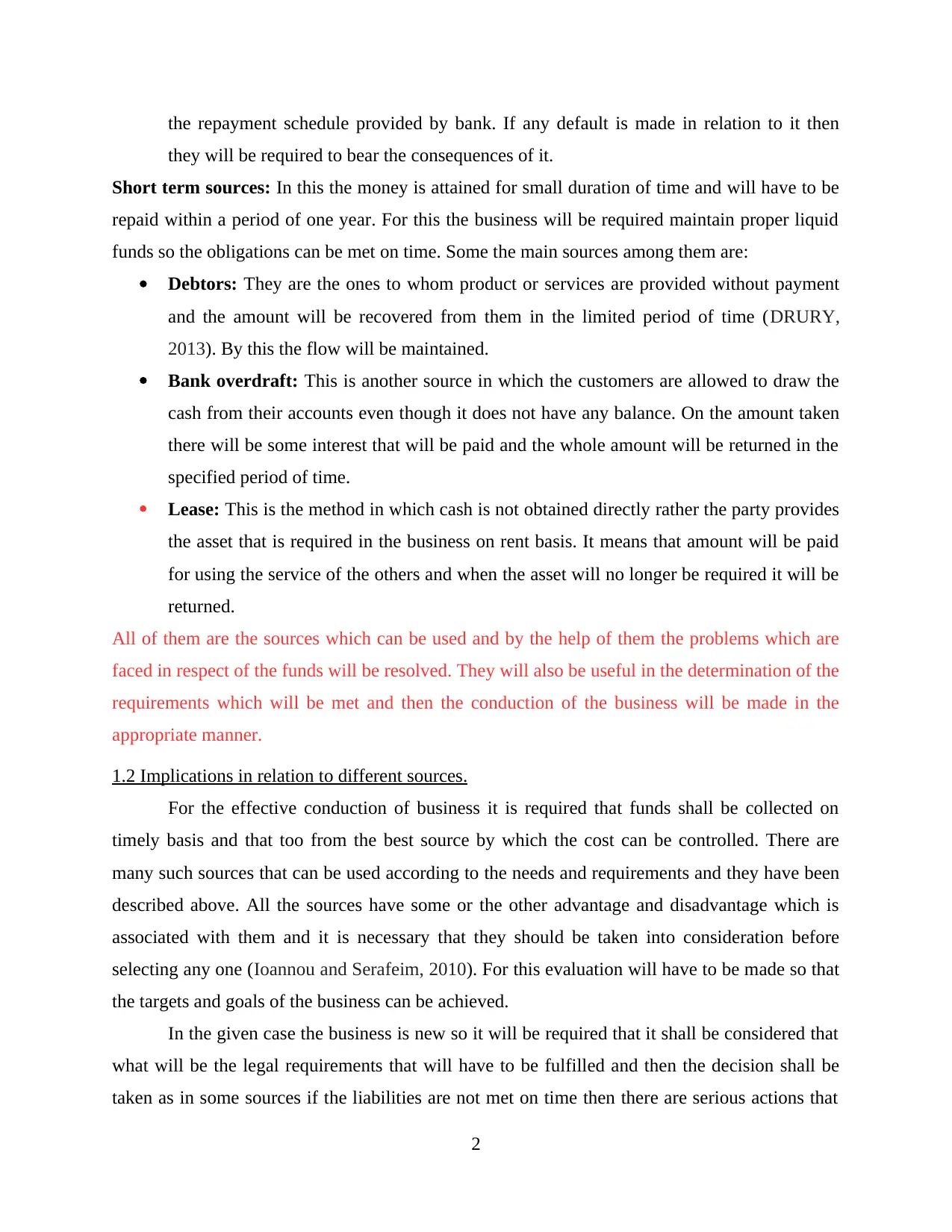
the repayment schedule provided by bank. If any default is made in relation to it then
they will be required to bear the consequences of it.
Short term sources: In this the money is attained for small duration of time and will have to be
repaid within a period of one year. For this the business will be required maintain proper liquid
funds so the obligations can be met on time. Some the main sources among them are:
Debtors: They are the ones to whom product or services are provided without payment
and the amount will be recovered from them in the limited period of time (DRURY,
2013). By this the flow will be maintained.
Bank overdraft: This is another source in which the customers are allowed to draw the
cash from their accounts even though it does not have any balance. On the amount taken
there will be some interest that will be paid and the whole amount will be returned in the
specified period of time.
Lease: This is the method in which cash is not obtained directly rather the party provides
the asset that is required in the business on rent basis. It means that amount will be paid
for using the service of the others and when the asset will no longer be required it will be
returned.
All of them are the sources which can be used and by the help of them the problems which are
faced in respect of the funds will be resolved. They will also be useful in the determination of the
requirements which will be met and then the conduction of the business will be made in the
appropriate manner.
1.2 Implications in relation to different sources.
For the effective conduction of business it is required that funds shall be collected on
timely basis and that too from the best source by which the cost can be controlled. There are
many such sources that can be used according to the needs and requirements and they have been
described above. All the sources have some or the other advantage and disadvantage which is
associated with them and it is necessary that they should be taken into consideration before
selecting any one (Ioannou and Serafeim, 2010). For this evaluation will have to be made so that
the targets and goals of the business can be achieved.
In the given case the business is new so it will be required that it shall be considered that
what will be the legal requirements that will have to be fulfilled and then the decision shall be
taken as in some sources if the liabilities are not met on time then there are serious actions that
2
they will be required to bear the consequences of it.
Short term sources: In this the money is attained for small duration of time and will have to be
repaid within a period of one year. For this the business will be required maintain proper liquid
funds so the obligations can be met on time. Some the main sources among them are:
Debtors: They are the ones to whom product or services are provided without payment
and the amount will be recovered from them in the limited period of time (DRURY,
2013). By this the flow will be maintained.
Bank overdraft: This is another source in which the customers are allowed to draw the
cash from their accounts even though it does not have any balance. On the amount taken
there will be some interest that will be paid and the whole amount will be returned in the
specified period of time.
Lease: This is the method in which cash is not obtained directly rather the party provides
the asset that is required in the business on rent basis. It means that amount will be paid
for using the service of the others and when the asset will no longer be required it will be
returned.
All of them are the sources which can be used and by the help of them the problems which are
faced in respect of the funds will be resolved. They will also be useful in the determination of the
requirements which will be met and then the conduction of the business will be made in the
appropriate manner.
1.2 Implications in relation to different sources.
For the effective conduction of business it is required that funds shall be collected on
timely basis and that too from the best source by which the cost can be controlled. There are
many such sources that can be used according to the needs and requirements and they have been
described above. All the sources have some or the other advantage and disadvantage which is
associated with them and it is necessary that they should be taken into consideration before
selecting any one (Ioannou and Serafeim, 2010). For this evaluation will have to be made so that
the targets and goals of the business can be achieved.
In the given case the business is new so it will be required that it shall be considered that
what will be the legal requirements that will have to be fulfilled and then the decision shall be
taken as in some sources if the liabilities are not met on time then there are serious actions that
2
Paraphrase This Document
Need a fresh take? Get an instant paraphrase of this document with our AI Paraphraser
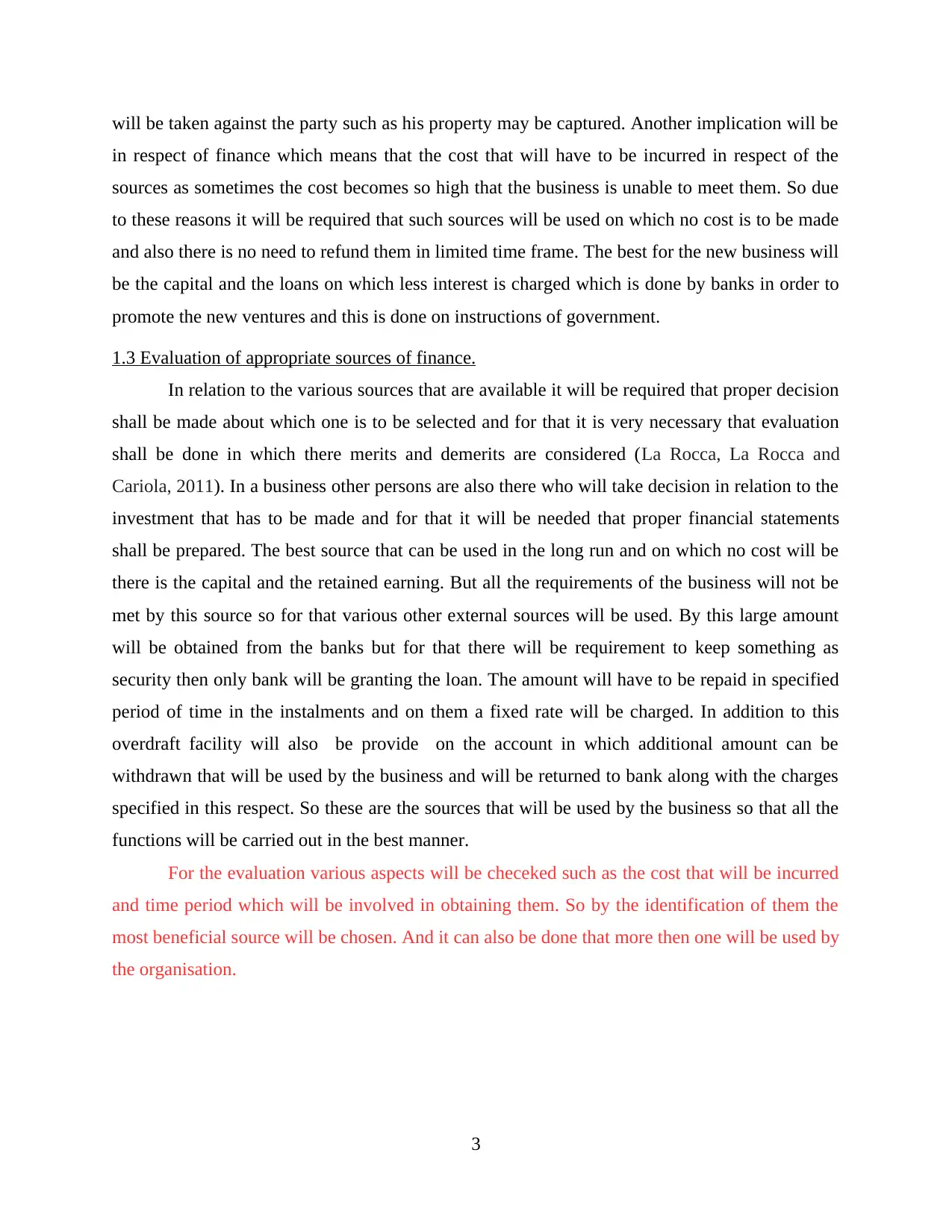
will be taken against the party such as his property may be captured. Another implication will be
in respect of finance which means that the cost that will have to be incurred in respect of the
sources as sometimes the cost becomes so high that the business is unable to meet them. So due
to these reasons it will be required that such sources will be used on which no cost is to be made
and also there is no need to refund them in limited time frame. The best for the new business will
be the capital and the loans on which less interest is charged which is done by banks in order to
promote the new ventures and this is done on instructions of government.
1.3 Evaluation of appropriate sources of finance.
In relation to the various sources that are available it will be required that proper decision
shall be made about which one is to be selected and for that it is very necessary that evaluation
shall be done in which there merits and demerits are considered (La Rocca, La Rocca and
Cariola, 2011). In a business other persons are also there who will take decision in relation to the
investment that has to be made and for that it will be needed that proper financial statements
shall be prepared. The best source that can be used in the long run and on which no cost will be
there is the capital and the retained earning. But all the requirements of the business will not be
met by this source so for that various other external sources will be used. By this large amount
will be obtained from the banks but for that there will be requirement to keep something as
security then only bank will be granting the loan. The amount will have to be repaid in specified
period of time in the instalments and on them a fixed rate will be charged. In addition to this
overdraft facility will also be provide on the account in which additional amount can be
withdrawn that will be used by the business and will be returned to bank along with the charges
specified in this respect. So these are the sources that will be used by the business so that all the
functions will be carried out in the best manner.
For the evaluation various aspects will be checeked such as the cost that will be incurred
and time period which will be involved in obtaining them. So by the identification of them the
most beneficial source will be chosen. And it can also be done that more then one will be used by
the organisation.
3
in respect of finance which means that the cost that will have to be incurred in respect of the
sources as sometimes the cost becomes so high that the business is unable to meet them. So due
to these reasons it will be required that such sources will be used on which no cost is to be made
and also there is no need to refund them in limited time frame. The best for the new business will
be the capital and the loans on which less interest is charged which is done by banks in order to
promote the new ventures and this is done on instructions of government.
1.3 Evaluation of appropriate sources of finance.
In relation to the various sources that are available it will be required that proper decision
shall be made about which one is to be selected and for that it is very necessary that evaluation
shall be done in which there merits and demerits are considered (La Rocca, La Rocca and
Cariola, 2011). In a business other persons are also there who will take decision in relation to the
investment that has to be made and for that it will be needed that proper financial statements
shall be prepared. The best source that can be used in the long run and on which no cost will be
there is the capital and the retained earning. But all the requirements of the business will not be
met by this source so for that various other external sources will be used. By this large amount
will be obtained from the banks but for that there will be requirement to keep something as
security then only bank will be granting the loan. The amount will have to be repaid in specified
period of time in the instalments and on them a fixed rate will be charged. In addition to this
overdraft facility will also be provide on the account in which additional amount can be
withdrawn that will be used by the business and will be returned to bank along with the charges
specified in this respect. So these are the sources that will be used by the business so that all the
functions will be carried out in the best manner.
For the evaluation various aspects will be checeked such as the cost that will be incurred
and time period which will be involved in obtaining them. So by the identification of them the
most beneficial source will be chosen. And it can also be done that more then one will be used by
the organisation.
3
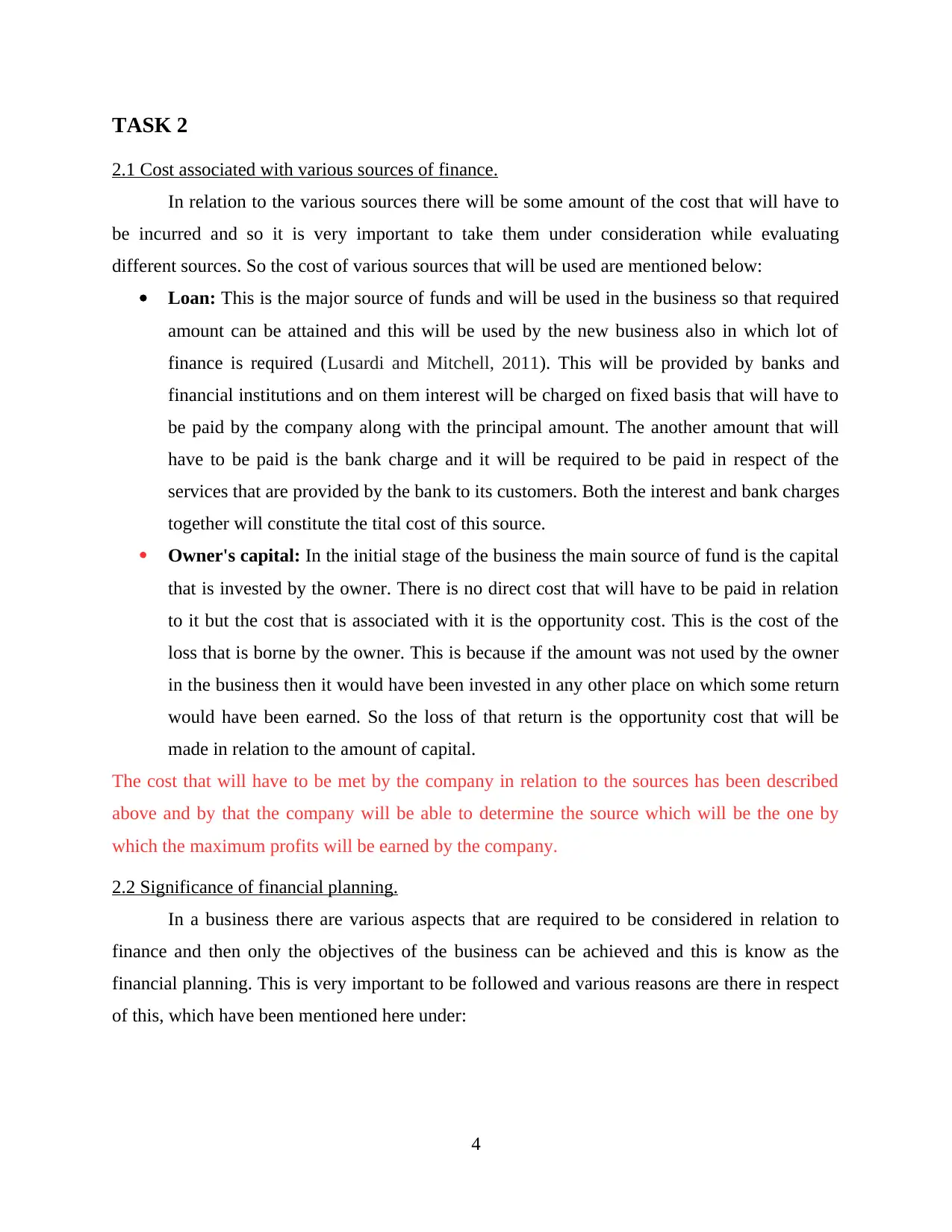
TASK 2
2.1 Cost associated with various sources of finance.
In relation to the various sources there will be some amount of the cost that will have to
be incurred and so it is very important to take them under consideration while evaluating
different sources. So the cost of various sources that will be used are mentioned below:
Loan: This is the major source of funds and will be used in the business so that required
amount can be attained and this will be used by the new business also in which lot of
finance is required (Lusardi and Mitchell, 2011). This will be provided by banks and
financial institutions and on them interest will be charged on fixed basis that will have to
be paid by the company along with the principal amount. The another amount that will
have to be paid is the bank charge and it will be required to be paid in respect of the
services that are provided by the bank to its customers. Both the interest and bank charges
together will constitute the tital cost of this source.
Owner's capital: In the initial stage of the business the main source of fund is the capital
that is invested by the owner. There is no direct cost that will have to be paid in relation
to it but the cost that is associated with it is the opportunity cost. This is the cost of the
loss that is borne by the owner. This is because if the amount was not used by the owner
in the business then it would have been invested in any other place on which some return
would have been earned. So the loss of that return is the opportunity cost that will be
made in relation to the amount of capital.
The cost that will have to be met by the company in relation to the sources has been described
above and by that the company will be able to determine the source which will be the one by
which the maximum profits will be earned by the company.
2.2 Significance of financial planning.
In a business there are various aspects that are required to be considered in relation to
finance and then only the objectives of the business can be achieved and this is know as the
financial planning. This is very important to be followed and various reasons are there in respect
of this, which have been mentioned here under:
4
2.1 Cost associated with various sources of finance.
In relation to the various sources there will be some amount of the cost that will have to
be incurred and so it is very important to take them under consideration while evaluating
different sources. So the cost of various sources that will be used are mentioned below:
Loan: This is the major source of funds and will be used in the business so that required
amount can be attained and this will be used by the new business also in which lot of
finance is required (Lusardi and Mitchell, 2011). This will be provided by banks and
financial institutions and on them interest will be charged on fixed basis that will have to
be paid by the company along with the principal amount. The another amount that will
have to be paid is the bank charge and it will be required to be paid in respect of the
services that are provided by the bank to its customers. Both the interest and bank charges
together will constitute the tital cost of this source.
Owner's capital: In the initial stage of the business the main source of fund is the capital
that is invested by the owner. There is no direct cost that will have to be paid in relation
to it but the cost that is associated with it is the opportunity cost. This is the cost of the
loss that is borne by the owner. This is because if the amount was not used by the owner
in the business then it would have been invested in any other place on which some return
would have been earned. So the loss of that return is the opportunity cost that will be
made in relation to the amount of capital.
The cost that will have to be met by the company in relation to the sources has been described
above and by that the company will be able to determine the source which will be the one by
which the maximum profits will be earned by the company.
2.2 Significance of financial planning.
In a business there are various aspects that are required to be considered in relation to
finance and then only the objectives of the business can be achieved and this is know as the
financial planning. This is very important to be followed and various reasons are there in respect
of this, which have been mentioned here under:
4
You're viewing a preview
Unlock full access by subscribing today!
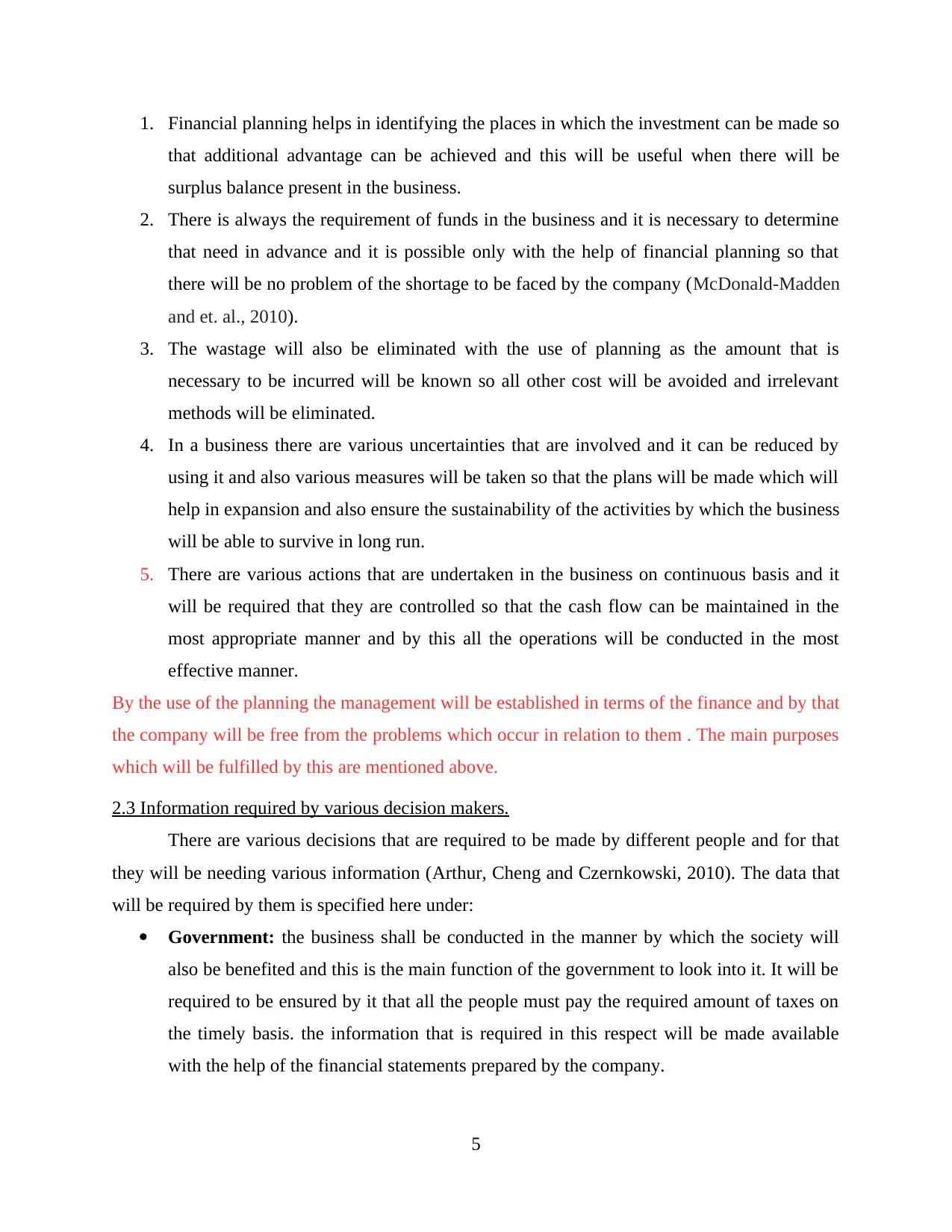
1. Financial planning helps in identifying the places in which the investment can be made so
that additional advantage can be achieved and this will be useful when there will be
surplus balance present in the business.
2. There is always the requirement of funds in the business and it is necessary to determine
that need in advance and it is possible only with the help of financial planning so that
there will be no problem of the shortage to be faced by the company (McDonald-Madden
and et. al., 2010).
3. The wastage will also be eliminated with the use of planning as the amount that is
necessary to be incurred will be known so all other cost will be avoided and irrelevant
methods will be eliminated.
4. In a business there are various uncertainties that are involved and it can be reduced by
using it and also various measures will be taken so that the plans will be made which will
help in expansion and also ensure the sustainability of the activities by which the business
will be able to survive in long run.
5. There are various actions that are undertaken in the business on continuous basis and it
will be required that they are controlled so that the cash flow can be maintained in the
most appropriate manner and by this all the operations will be conducted in the most
effective manner.
By the use of the planning the management will be established in terms of the finance and by that
the company will be free from the problems which occur in relation to them . The main purposes
which will be fulfilled by this are mentioned above.
2.3 Information required by various decision makers.
There are various decisions that are required to be made by different people and for that
they will be needing various information (Arthur, Cheng and Czernkowski, 2010). The data that
will be required by them is specified here under:
Government: the business shall be conducted in the manner by which the society will
also be benefited and this is the main function of the government to look into it. It will be
required to be ensured by it that all the people must pay the required amount of taxes on
the timely basis. the information that is required in this respect will be made available
with the help of the financial statements prepared by the company.
5
that additional advantage can be achieved and this will be useful when there will be
surplus balance present in the business.
2. There is always the requirement of funds in the business and it is necessary to determine
that need in advance and it is possible only with the help of financial planning so that
there will be no problem of the shortage to be faced by the company (McDonald-Madden
and et. al., 2010).
3. The wastage will also be eliminated with the use of planning as the amount that is
necessary to be incurred will be known so all other cost will be avoided and irrelevant
methods will be eliminated.
4. In a business there are various uncertainties that are involved and it can be reduced by
using it and also various measures will be taken so that the plans will be made which will
help in expansion and also ensure the sustainability of the activities by which the business
will be able to survive in long run.
5. There are various actions that are undertaken in the business on continuous basis and it
will be required that they are controlled so that the cash flow can be maintained in the
most appropriate manner and by this all the operations will be conducted in the most
effective manner.
By the use of the planning the management will be established in terms of the finance and by that
the company will be free from the problems which occur in relation to them . The main purposes
which will be fulfilled by this are mentioned above.
2.3 Information required by various decision makers.
There are various decisions that are required to be made by different people and for that
they will be needing various information (Arthur, Cheng and Czernkowski, 2010). The data that
will be required by them is specified here under:
Government: the business shall be conducted in the manner by which the society will
also be benefited and this is the main function of the government to look into it. It will be
required to be ensured by it that all the people must pay the required amount of taxes on
the timely basis. the information that is required in this respect will be made available
with the help of the financial statements prepared by the company.
5
Paraphrase This Document
Need a fresh take? Get an instant paraphrase of this document with our AI Paraphraser
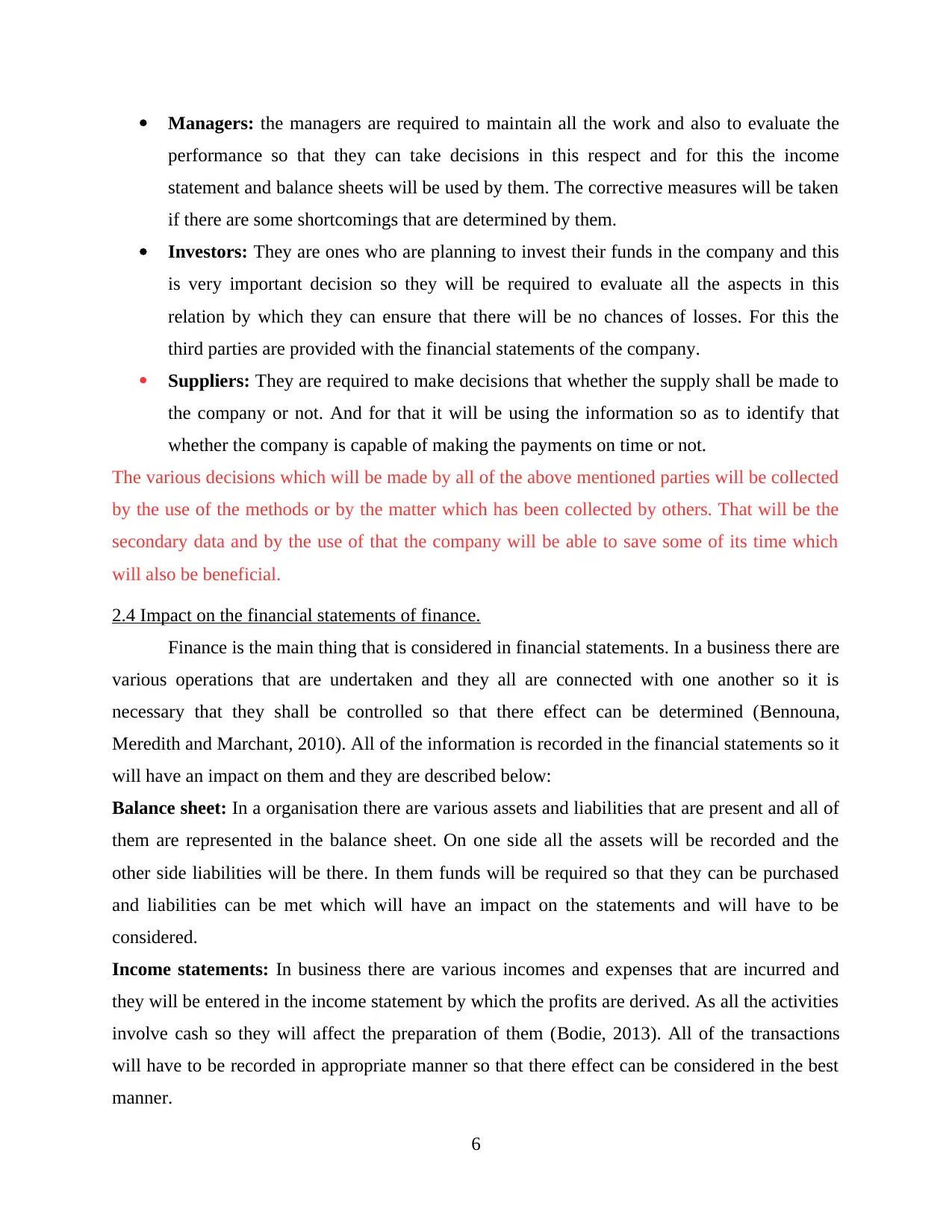
Managers: the managers are required to maintain all the work and also to evaluate the
performance so that they can take decisions in this respect and for this the income
statement and balance sheets will be used by them. The corrective measures will be taken
if there are some shortcomings that are determined by them.
Investors: They are ones who are planning to invest their funds in the company and this
is very important decision so they will be required to evaluate all the aspects in this
relation by which they can ensure that there will be no chances of losses. For this the
third parties are provided with the financial statements of the company.
Suppliers: They are required to make decisions that whether the supply shall be made to
the company or not. And for that it will be using the information so as to identify that
whether the company is capable of making the payments on time or not.
The various decisions which will be made by all of the above mentioned parties will be collected
by the use of the methods or by the matter which has been collected by others. That will be the
secondary data and by the use of that the company will be able to save some of its time which
will also be beneficial.
2.4 Impact on the financial statements of finance.
Finance is the main thing that is considered in financial statements. In a business there are
various operations that are undertaken and they all are connected with one another so it is
necessary that they shall be controlled so that there effect can be determined (Bennouna,
Meredith and Marchant, 2010). All of the information is recorded in the financial statements so it
will have an impact on them and they are described below:
Balance sheet: In a organisation there are various assets and liabilities that are present and all of
them are represented in the balance sheet. On one side all the assets will be recorded and the
other side liabilities will be there. In them funds will be required so that they can be purchased
and liabilities can be met which will have an impact on the statements and will have to be
considered.
Income statements: In business there are various incomes and expenses that are incurred and
they will be entered in the income statement by which the profits are derived. As all the activities
involve cash so they will affect the preparation of them (Bodie, 2013). All of the transactions
will have to be recorded in appropriate manner so that there effect can be considered in the best
manner.
6
performance so that they can take decisions in this respect and for this the income
statement and balance sheets will be used by them. The corrective measures will be taken
if there are some shortcomings that are determined by them.
Investors: They are ones who are planning to invest their funds in the company and this
is very important decision so they will be required to evaluate all the aspects in this
relation by which they can ensure that there will be no chances of losses. For this the
third parties are provided with the financial statements of the company.
Suppliers: They are required to make decisions that whether the supply shall be made to
the company or not. And for that it will be using the information so as to identify that
whether the company is capable of making the payments on time or not.
The various decisions which will be made by all of the above mentioned parties will be collected
by the use of the methods or by the matter which has been collected by others. That will be the
secondary data and by the use of that the company will be able to save some of its time which
will also be beneficial.
2.4 Impact on the financial statements of finance.
Finance is the main thing that is considered in financial statements. In a business there are
various operations that are undertaken and they all are connected with one another so it is
necessary that they shall be controlled so that there effect can be determined (Bennouna,
Meredith and Marchant, 2010). All of the information is recorded in the financial statements so it
will have an impact on them and they are described below:
Balance sheet: In a organisation there are various assets and liabilities that are present and all of
them are represented in the balance sheet. On one side all the assets will be recorded and the
other side liabilities will be there. In them funds will be required so that they can be purchased
and liabilities can be met which will have an impact on the statements and will have to be
considered.
Income statements: In business there are various incomes and expenses that are incurred and
they will be entered in the income statement by which the profits are derived. As all the activities
involve cash so they will affect the preparation of them (Bodie, 2013). All of the transactions
will have to be recorded in appropriate manner so that there effect can be considered in the best
manner.
6
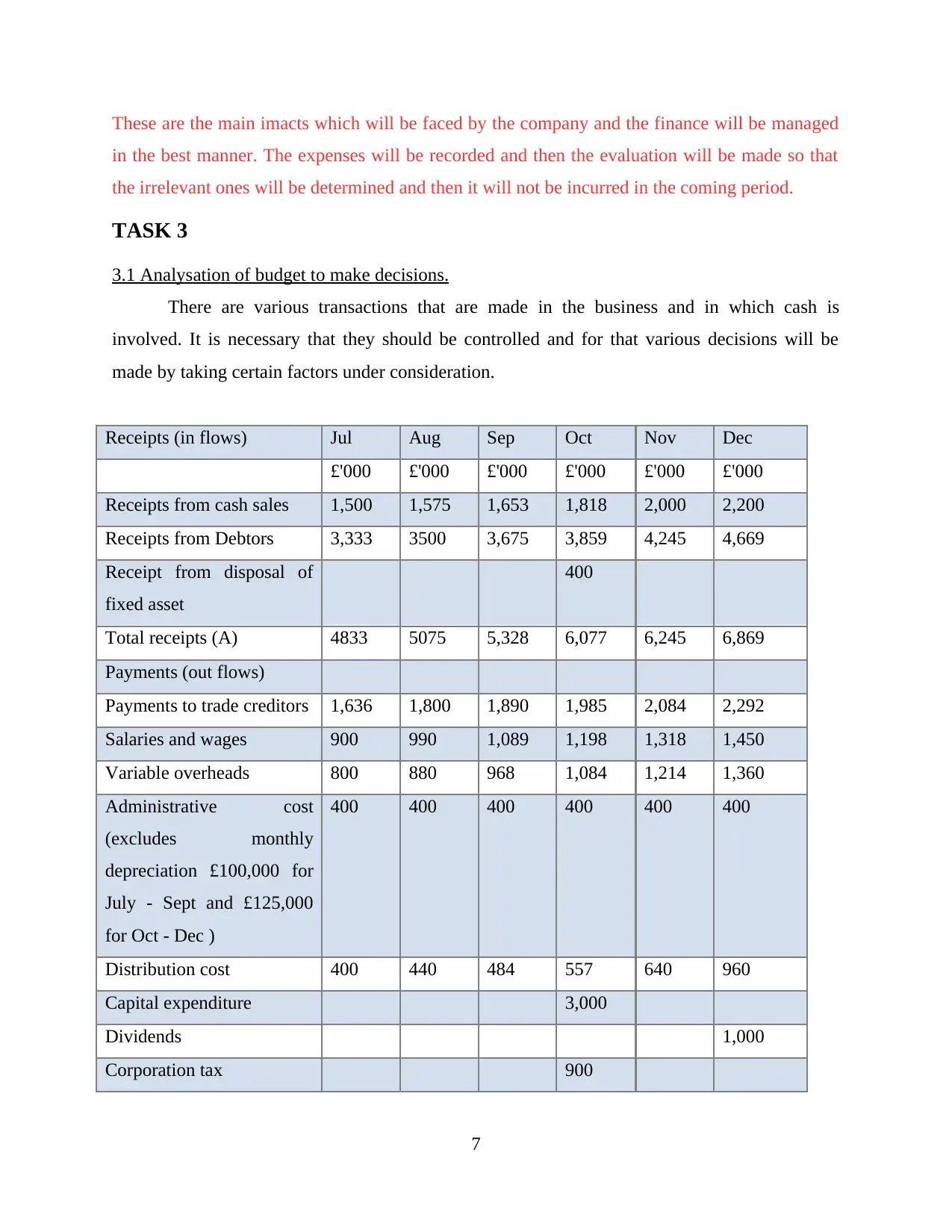
These are the main imacts which will be faced by the company and the finance will be managed
in the best manner. The expenses will be recorded and then the evaluation will be made so that
the irrelevant ones will be determined and then it will not be incurred in the coming period.
TASK 3
3.1 Analysation of budget to make decisions.
There are various transactions that are made in the business and in which cash is
involved. It is necessary that they should be controlled and for that various decisions will be
made by taking certain factors under consideration.
Receipts (in flows) Jul Aug Sep Oct Nov Dec
£'000 £'000 £'000 £'000 £'000 £'000
Receipts from cash sales 1,500 1,575 1,653 1,818 2,000 2,200
Receipts from Debtors 3,333 3500 3,675 3,859 4,245 4,669
Receipt from disposal of
fixed asset
400
Total receipts (A) 4833 5075 5,328 6,077 6,245 6,869
Payments (out flows)
Payments to trade creditors 1,636 1,800 1,890 1,985 2,084 2,292
Salaries and wages 900 990 1,089 1,198 1,318 1,450
Variable overheads 800 880 968 1,084 1,214 1,360
Administrative cost
(excludes monthly
depreciation £100,000 for
July - Sept and £125,000
for Oct - Dec )
400 400 400 400 400 400
Distribution cost 400 440 484 557 640 960
Capital expenditure 3,000
Dividends 1,000
Corporation tax 900
7
in the best manner. The expenses will be recorded and then the evaluation will be made so that
the irrelevant ones will be determined and then it will not be incurred in the coming period.
TASK 3
3.1 Analysation of budget to make decisions.
There are various transactions that are made in the business and in which cash is
involved. It is necessary that they should be controlled and for that various decisions will be
made by taking certain factors under consideration.
Receipts (in flows) Jul Aug Sep Oct Nov Dec
£'000 £'000 £'000 £'000 £'000 £'000
Receipts from cash sales 1,500 1,575 1,653 1,818 2,000 2,200
Receipts from Debtors 3,333 3500 3,675 3,859 4,245 4,669
Receipt from disposal of
fixed asset
400
Total receipts (A) 4833 5075 5,328 6,077 6,245 6,869
Payments (out flows)
Payments to trade creditors 1,636 1,800 1,890 1,985 2,084 2,292
Salaries and wages 900 990 1,089 1,198 1,318 1,450
Variable overheads 800 880 968 1,084 1,214 1,360
Administrative cost
(excludes monthly
depreciation £100,000 for
July - Sept and £125,000
for Oct - Dec )
400 400 400 400 400 400
Distribution cost 400 440 484 557 640 960
Capital expenditure 3,000
Dividends 1,000
Corporation tax 900
7
You're viewing a preview
Unlock full access by subscribing today!
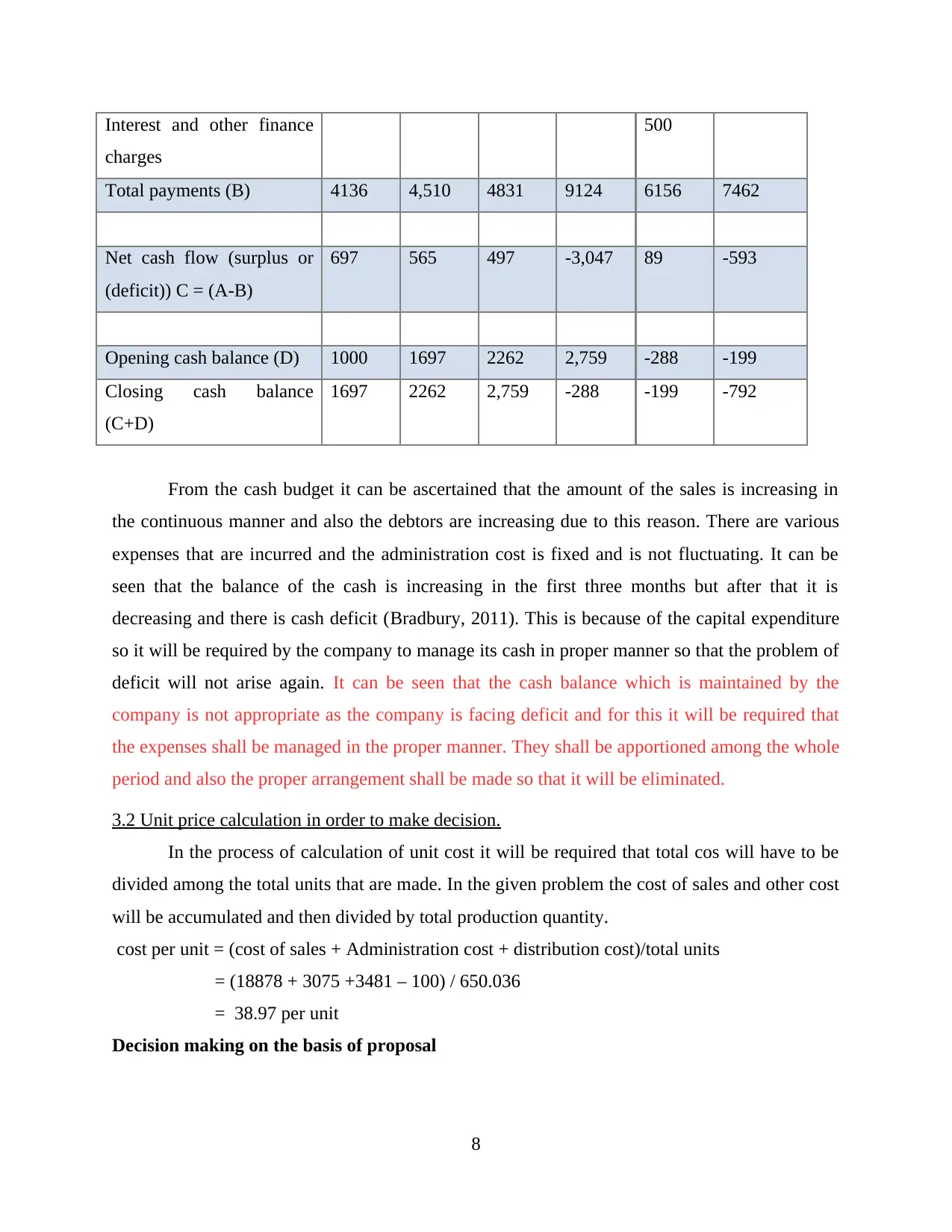
Interest and other finance
charges
500
Total payments (B) 4136 4,510 4831 9124 6156 7462
Net cash flow (surplus or
(deficit)) C = (A-B)
697 565 497 -3,047 89 -593
Opening cash balance (D) 1000 1697 2262 2,759 -288 -199
Closing cash balance
(C+D)
1697 2262 2,759 -288 -199 -792
From the cash budget it can be ascertained that the amount of the sales is increasing in
the continuous manner and also the debtors are increasing due to this reason. There are various
expenses that are incurred and the administration cost is fixed and is not fluctuating. It can be
seen that the balance of the cash is increasing in the first three months but after that it is
decreasing and there is cash deficit (Bradbury, 2011). This is because of the capital expenditure
so it will be required by the company to manage its cash in proper manner so that the problem of
deficit will not arise again. It can be seen that the cash balance which is maintained by the
company is not appropriate as the company is facing deficit and for this it will be required that
the expenses shall be managed in the proper manner. They shall be apportioned among the whole
period and also the proper arrangement shall be made so that it will be eliminated.
3.2 Unit price calculation in order to make decision.
In the process of calculation of unit cost it will be required that total cos will have to be
divided among the total units that are made. In the given problem the cost of sales and other cost
will be accumulated and then divided by total production quantity.
cost per unit = (cost of sales + Administration cost + distribution cost)/total units
= (18878 + 3075 +3481 – 100) / 650.036
= 38.97 per unit
Decision making on the basis of proposal
8
charges
500
Total payments (B) 4136 4,510 4831 9124 6156 7462
Net cash flow (surplus or
(deficit)) C = (A-B)
697 565 497 -3,047 89 -593
Opening cash balance (D) 1000 1697 2262 2,759 -288 -199
Closing cash balance
(C+D)
1697 2262 2,759 -288 -199 -792
From the cash budget it can be ascertained that the amount of the sales is increasing in
the continuous manner and also the debtors are increasing due to this reason. There are various
expenses that are incurred and the administration cost is fixed and is not fluctuating. It can be
seen that the balance of the cash is increasing in the first three months but after that it is
decreasing and there is cash deficit (Bradbury, 2011). This is because of the capital expenditure
so it will be required by the company to manage its cash in proper manner so that the problem of
deficit will not arise again. It can be seen that the cash balance which is maintained by the
company is not appropriate as the company is facing deficit and for this it will be required that
the expenses shall be managed in the proper manner. They shall be apportioned among the whole
period and also the proper arrangement shall be made so that it will be eliminated.
3.2 Unit price calculation in order to make decision.
In the process of calculation of unit cost it will be required that total cos will have to be
divided among the total units that are made. In the given problem the cost of sales and other cost
will be accumulated and then divided by total production quantity.
cost per unit = (cost of sales + Administration cost + distribution cost)/total units
= (18878 + 3075 +3481 – 100) / 650.036
= 38.97 per unit
Decision making on the basis of proposal
8
Paraphrase This Document
Need a fresh take? Get an instant paraphrase of this document with our AI Paraphraser
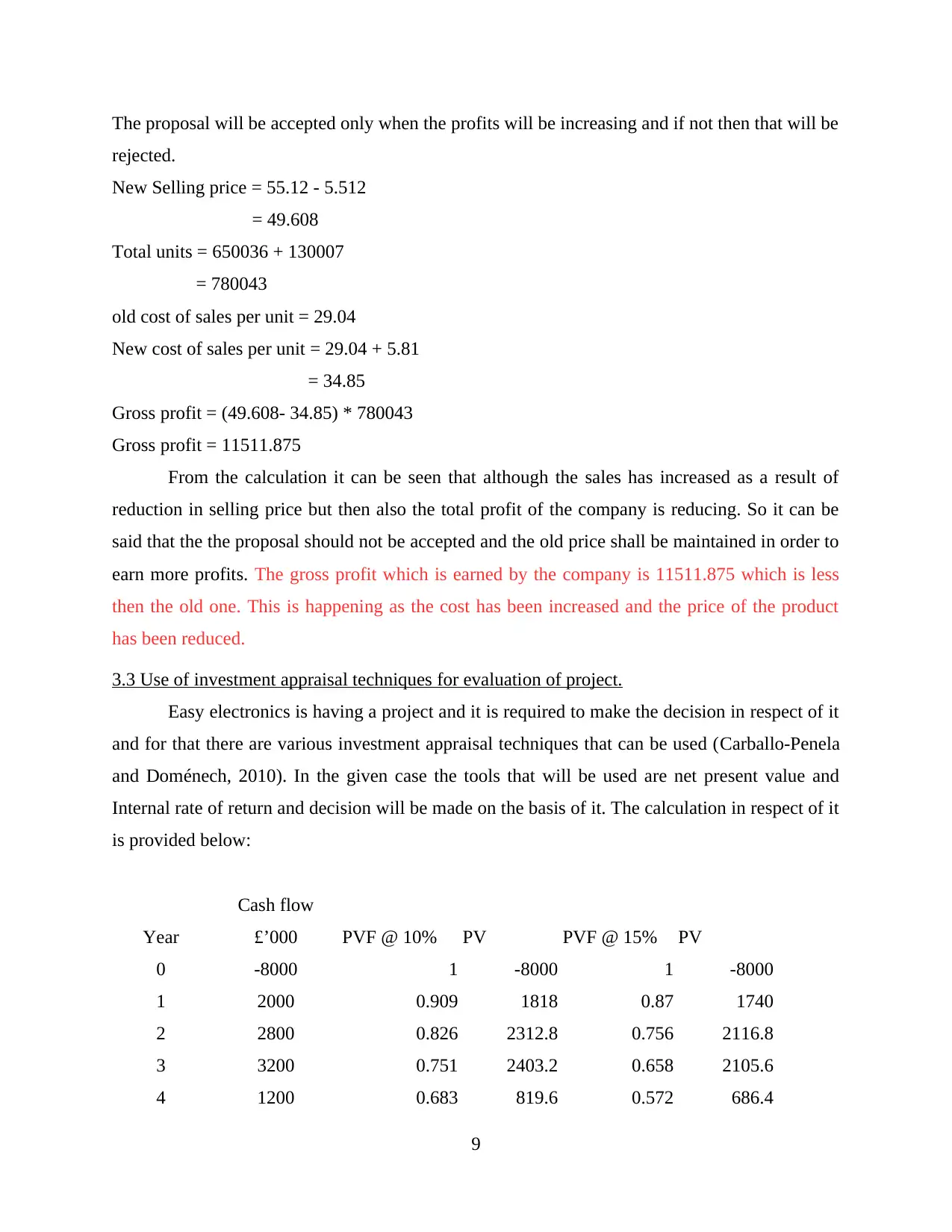
The proposal will be accepted only when the profits will be increasing and if not then that will be
rejected.
New Selling price = 55.12 - 5.512
= 49.608
Total units = 650036 + 130007
= 780043
old cost of sales per unit = 29.04
New cost of sales per unit = 29.04 + 5.81
= 34.85
Gross profit = (49.608- 34.85) * 780043
Gross profit = 11511.875
From the calculation it can be seen that although the sales has increased as a result of
reduction in selling price but then also the total profit of the company is reducing. So it can be
said that the the proposal should not be accepted and the old price shall be maintained in order to
earn more profits. The gross profit which is earned by the company is 11511.875 which is less
then the old one. This is happening as the cost has been increased and the price of the product
has been reduced.
3.3 Use of investment appraisal techniques for evaluation of project.
Easy electronics is having a project and it is required to make the decision in respect of it
and for that there are various investment appraisal techniques that can be used (Carballo-Penela
and Doménech, 2010). In the given case the tools that will be used are net present value and
Internal rate of return and decision will be made on the basis of it. The calculation in respect of it
is provided below:
Year
Cash flow
£’000 PVF @ 10% PV PVF @ 15% PV
0 -8000 1 -8000 1 -8000
1 2000 0.909 1818 0.87 1740
2 2800 0.826 2312.8 0.756 2116.8
3 3200 0.751 2403.2 0.658 2105.6
4 1200 0.683 819.6 0.572 686.4
9
rejected.
New Selling price = 55.12 - 5.512
= 49.608
Total units = 650036 + 130007
= 780043
old cost of sales per unit = 29.04
New cost of sales per unit = 29.04 + 5.81
= 34.85
Gross profit = (49.608- 34.85) * 780043
Gross profit = 11511.875
From the calculation it can be seen that although the sales has increased as a result of
reduction in selling price but then also the total profit of the company is reducing. So it can be
said that the the proposal should not be accepted and the old price shall be maintained in order to
earn more profits. The gross profit which is earned by the company is 11511.875 which is less
then the old one. This is happening as the cost has been increased and the price of the product
has been reduced.
3.3 Use of investment appraisal techniques for evaluation of project.
Easy electronics is having a project and it is required to make the decision in respect of it
and for that there are various investment appraisal techniques that can be used (Carballo-Penela
and Doménech, 2010). In the given case the tools that will be used are net present value and
Internal rate of return and decision will be made on the basis of it. The calculation in respect of it
is provided below:
Year
Cash flow
£’000 PVF @ 10% PV PVF @ 15% PV
0 -8000 1 -8000 1 -8000
1 2000 0.909 1818 0.87 1740
2 2800 0.826 2312.8 0.756 2116.8
3 3200 0.751 2403.2 0.658 2105.6
4 1200 0.683 819.6 0.572 686.4
9
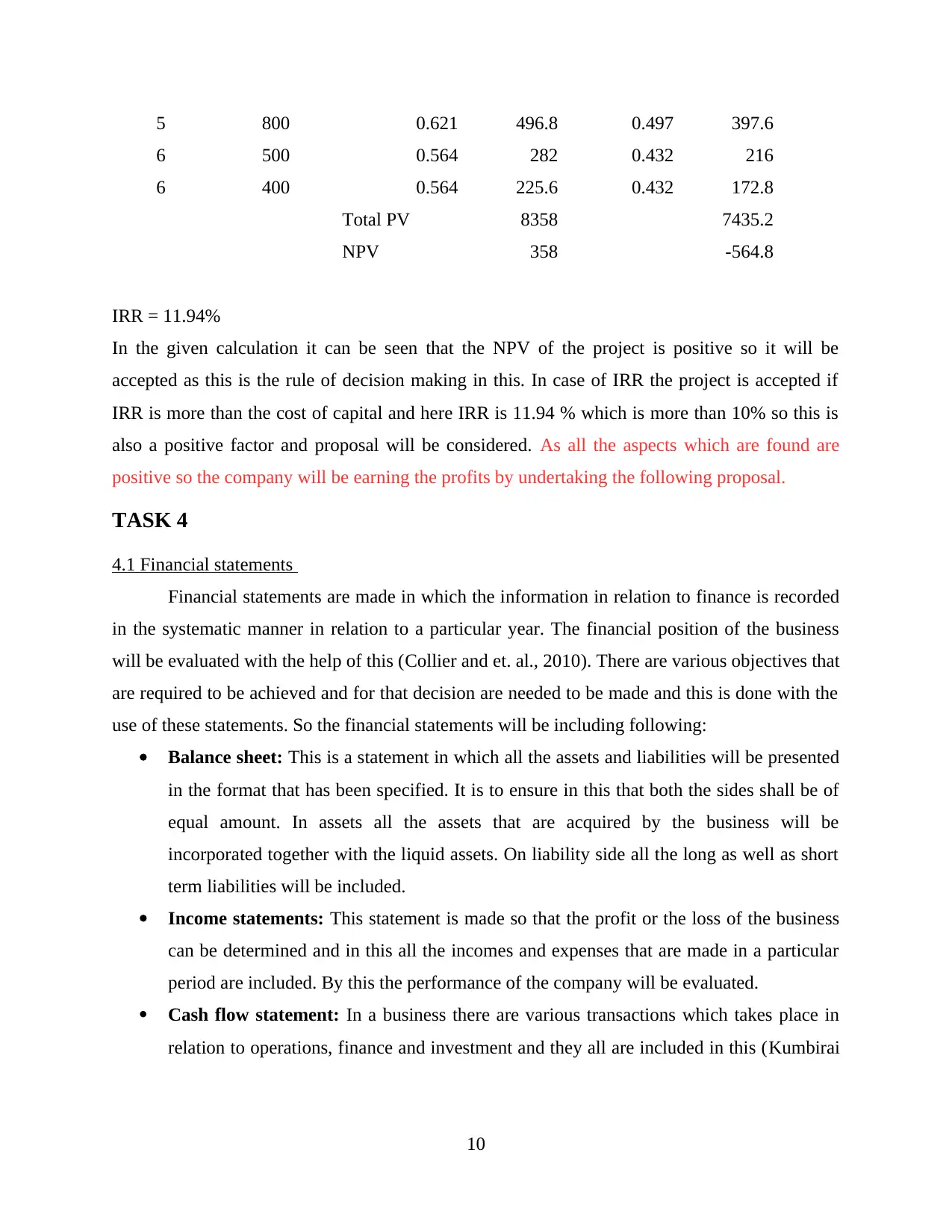
5 800 0.621 496.8 0.497 397.6
6 500 0.564 282 0.432 216
6 400 0.564 225.6 0.432 172.8
Total PV 8358 7435.2
NPV 358 -564.8
IRR = 11.94%
In the given calculation it can be seen that the NPV of the project is positive so it will be
accepted as this is the rule of decision making in this. In case of IRR the project is accepted if
IRR is more than the cost of capital and here IRR is 11.94 % which is more than 10% so this is
also a positive factor and proposal will be considered. As all the aspects which are found are
positive so the company will be earning the profits by undertaking the following proposal.
TASK 4
4.1 Financial statements
Financial statements are made in which the information in relation to finance is recorded
in the systematic manner in relation to a particular year. The financial position of the business
will be evaluated with the help of this (Collier and et. al., 2010). There are various objectives that
are required to be achieved and for that decision are needed to be made and this is done with the
use of these statements. So the financial statements will be including following:
Balance sheet: This is a statement in which all the assets and liabilities will be presented
in the format that has been specified. It is to ensure in this that both the sides shall be of
equal amount. In assets all the assets that are acquired by the business will be
incorporated together with the liquid assets. On liability side all the long as well as short
term liabilities will be included.
Income statements: This statement is made so that the profit or the loss of the business
can be determined and in this all the incomes and expenses that are made in a particular
period are included. By this the performance of the company will be evaluated.
Cash flow statement: In a business there are various transactions which takes place in
relation to operations, finance and investment and they all are included in this (Kumbirai
10
6 500 0.564 282 0.432 216
6 400 0.564 225.6 0.432 172.8
Total PV 8358 7435.2
NPV 358 -564.8
IRR = 11.94%
In the given calculation it can be seen that the NPV of the project is positive so it will be
accepted as this is the rule of decision making in this. In case of IRR the project is accepted if
IRR is more than the cost of capital and here IRR is 11.94 % which is more than 10% so this is
also a positive factor and proposal will be considered. As all the aspects which are found are
positive so the company will be earning the profits by undertaking the following proposal.
TASK 4
4.1 Financial statements
Financial statements are made in which the information in relation to finance is recorded
in the systematic manner in relation to a particular year. The financial position of the business
will be evaluated with the help of this (Collier and et. al., 2010). There are various objectives that
are required to be achieved and for that decision are needed to be made and this is done with the
use of these statements. So the financial statements will be including following:
Balance sheet: This is a statement in which all the assets and liabilities will be presented
in the format that has been specified. It is to ensure in this that both the sides shall be of
equal amount. In assets all the assets that are acquired by the business will be
incorporated together with the liquid assets. On liability side all the long as well as short
term liabilities will be included.
Income statements: This statement is made so that the profit or the loss of the business
can be determined and in this all the incomes and expenses that are made in a particular
period are included. By this the performance of the company will be evaluated.
Cash flow statement: In a business there are various transactions which takes place in
relation to operations, finance and investment and they all are included in this (Kumbirai
10
You're viewing a preview
Unlock full access by subscribing today!
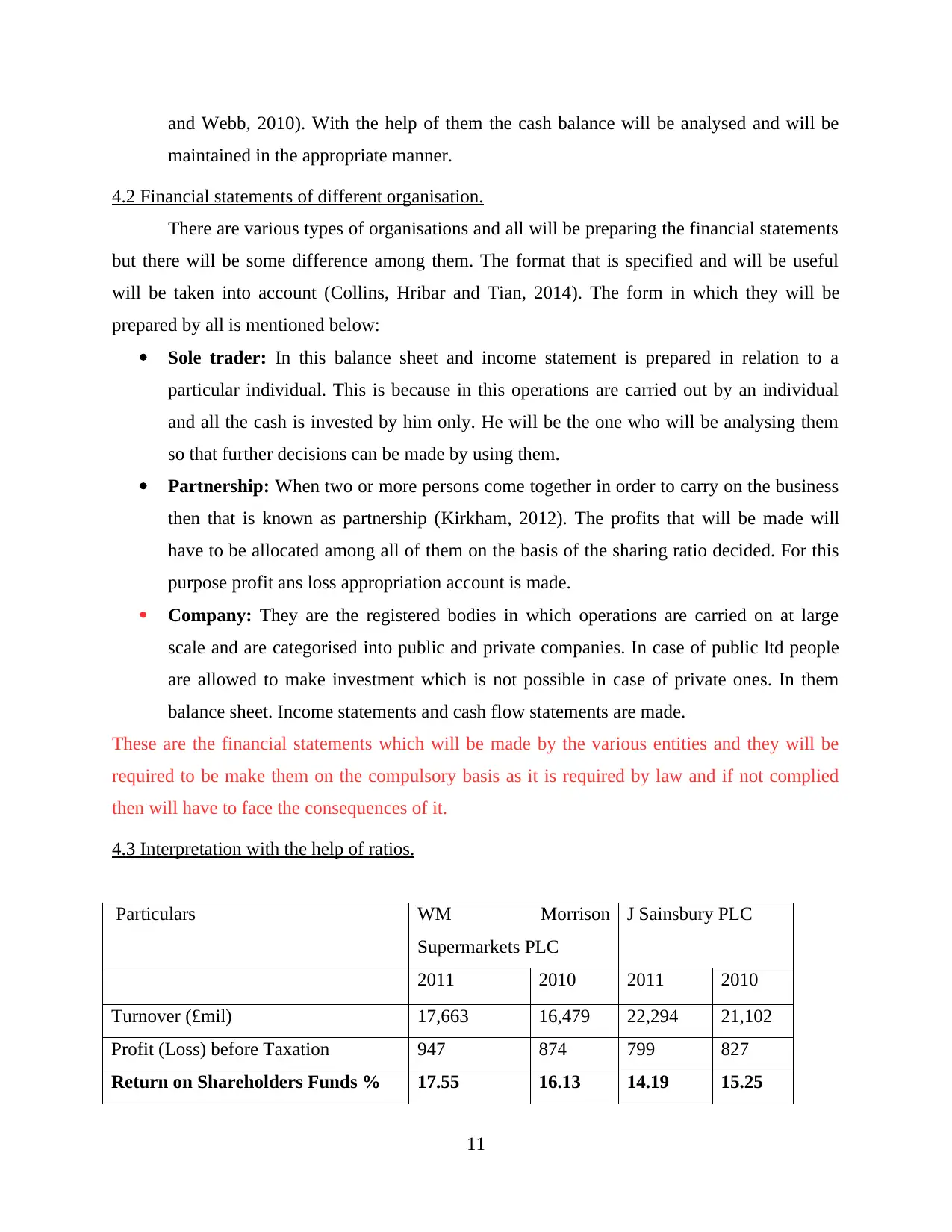
and Webb, 2010). With the help of them the cash balance will be analysed and will be
maintained in the appropriate manner.
4.2 Financial statements of different organisation.
There are various types of organisations and all will be preparing the financial statements
but there will be some difference among them. The format that is specified and will be useful
will be taken into account (Collins, Hribar and Tian, 2014). The form in which they will be
prepared by all is mentioned below:
Sole trader: In this balance sheet and income statement is prepared in relation to a
particular individual. This is because in this operations are carried out by an individual
and all the cash is invested by him only. He will be the one who will be analysing them
so that further decisions can be made by using them.
Partnership: When two or more persons come together in order to carry on the business
then that is known as partnership (Kirkham, 2012). The profits that will be made will
have to be allocated among all of them on the basis of the sharing ratio decided. For this
purpose profit ans loss appropriation account is made.
Company: They are the registered bodies in which operations are carried on at large
scale and are categorised into public and private companies. In case of public ltd people
are allowed to make investment which is not possible in case of private ones. In them
balance sheet. Income statements and cash flow statements are made.
These are the financial statements which will be made by the various entities and they will be
required to be make them on the compulsory basis as it is required by law and if not complied
then will have to face the consequences of it.
4.3 Interpretation with the help of ratios.
Particulars WM Morrison
Supermarkets PLC
J Sainsbury PLC
2011 2010 2011 2010
Turnover (£mil) 17,663 16,479 22,294 21,102
Profit (Loss) before Taxation 947 874 799 827
Return on Shareholders Funds % 17.55 16.13 14.19 15.25
11
maintained in the appropriate manner.
4.2 Financial statements of different organisation.
There are various types of organisations and all will be preparing the financial statements
but there will be some difference among them. The format that is specified and will be useful
will be taken into account (Collins, Hribar and Tian, 2014). The form in which they will be
prepared by all is mentioned below:
Sole trader: In this balance sheet and income statement is prepared in relation to a
particular individual. This is because in this operations are carried out by an individual
and all the cash is invested by him only. He will be the one who will be analysing them
so that further decisions can be made by using them.
Partnership: When two or more persons come together in order to carry on the business
then that is known as partnership (Kirkham, 2012). The profits that will be made will
have to be allocated among all of them on the basis of the sharing ratio decided. For this
purpose profit ans loss appropriation account is made.
Company: They are the registered bodies in which operations are carried on at large
scale and are categorised into public and private companies. In case of public ltd people
are allowed to make investment which is not possible in case of private ones. In them
balance sheet. Income statements and cash flow statements are made.
These are the financial statements which will be made by the various entities and they will be
required to be make them on the compulsory basis as it is required by law and if not complied
then will have to face the consequences of it.
4.3 Interpretation with the help of ratios.
Particulars WM Morrison
Supermarkets PLC
J Sainsbury PLC
2011 2010 2011 2010
Turnover (£mil) 17,663 16,479 22,294 21,102
Profit (Loss) before Taxation 947 874 799 827
Return on Shareholders Funds % 17.55 16.13 14.19 15.25
11
Paraphrase This Document
Need a fresh take? Get an instant paraphrase of this document with our AI Paraphraser
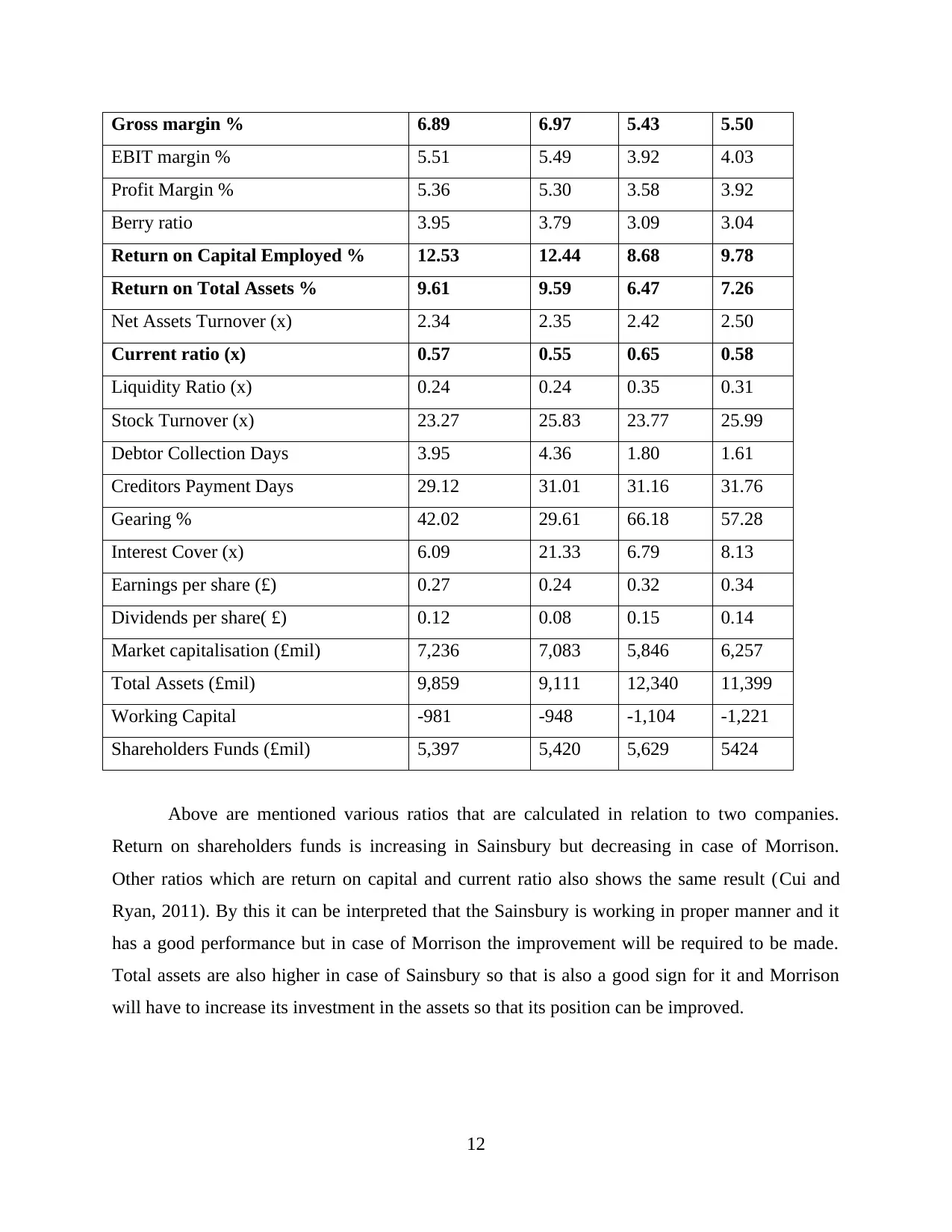
Gross margin % 6.89 6.97 5.43 5.50
EBIT margin % 5.51 5.49 3.92 4.03
Profit Margin % 5.36 5.30 3.58 3.92
Berry ratio 3.95 3.79 3.09 3.04
Return on Capital Employed % 12.53 12.44 8.68 9.78
Return on Total Assets % 9.61 9.59 6.47 7.26
Net Assets Turnover (x) 2.34 2.35 2.42 2.50
Current ratio (x) 0.57 0.55 0.65 0.58
Liquidity Ratio (x) 0.24 0.24 0.35 0.31
Stock Turnover (x) 23.27 25.83 23.77 25.99
Debtor Collection Days 3.95 4.36 1.80 1.61
Creditors Payment Days 29.12 31.01 31.16 31.76
Gearing % 42.02 29.61 66.18 57.28
Interest Cover (x) 6.09 21.33 6.79 8.13
Earnings per share (£) 0.27 0.24 0.32 0.34
Dividends per share( £) 0.12 0.08 0.15 0.14
Market capitalisation (£mil) 7,236 7,083 5,846 6,257
Total Assets (£mil) 9,859 9,111 12,340 11,399
Working Capital -981 -948 -1,104 -1,221
Shareholders Funds (£mil) 5,397 5,420 5,629 5424
Above are mentioned various ratios that are calculated in relation to two companies.
Return on shareholders funds is increasing in Sainsbury but decreasing in case of Morrison.
Other ratios which are return on capital and current ratio also shows the same result (Cui and
Ryan, 2011). By this it can be interpreted that the Sainsbury is working in proper manner and it
has a good performance but in case of Morrison the improvement will be required to be made.
Total assets are also higher in case of Sainsbury so that is also a good sign for it and Morrison
will have to increase its investment in the assets so that its position can be improved.
12
EBIT margin % 5.51 5.49 3.92 4.03
Profit Margin % 5.36 5.30 3.58 3.92
Berry ratio 3.95 3.79 3.09 3.04
Return on Capital Employed % 12.53 12.44 8.68 9.78
Return on Total Assets % 9.61 9.59 6.47 7.26
Net Assets Turnover (x) 2.34 2.35 2.42 2.50
Current ratio (x) 0.57 0.55 0.65 0.58
Liquidity Ratio (x) 0.24 0.24 0.35 0.31
Stock Turnover (x) 23.27 25.83 23.77 25.99
Debtor Collection Days 3.95 4.36 1.80 1.61
Creditors Payment Days 29.12 31.01 31.16 31.76
Gearing % 42.02 29.61 66.18 57.28
Interest Cover (x) 6.09 21.33 6.79 8.13
Earnings per share (£) 0.27 0.24 0.32 0.34
Dividends per share( £) 0.12 0.08 0.15 0.14
Market capitalisation (£mil) 7,236 7,083 5,846 6,257
Total Assets (£mil) 9,859 9,111 12,340 11,399
Working Capital -981 -948 -1,104 -1,221
Shareholders Funds (£mil) 5,397 5,420 5,629 5424
Above are mentioned various ratios that are calculated in relation to two companies.
Return on shareholders funds is increasing in Sainsbury but decreasing in case of Morrison.
Other ratios which are return on capital and current ratio also shows the same result (Cui and
Ryan, 2011). By this it can be interpreted that the Sainsbury is working in proper manner and it
has a good performance but in case of Morrison the improvement will be required to be made.
Total assets are also higher in case of Sainsbury so that is also a good sign for it and Morrison
will have to increase its investment in the assets so that its position can be improved.
12
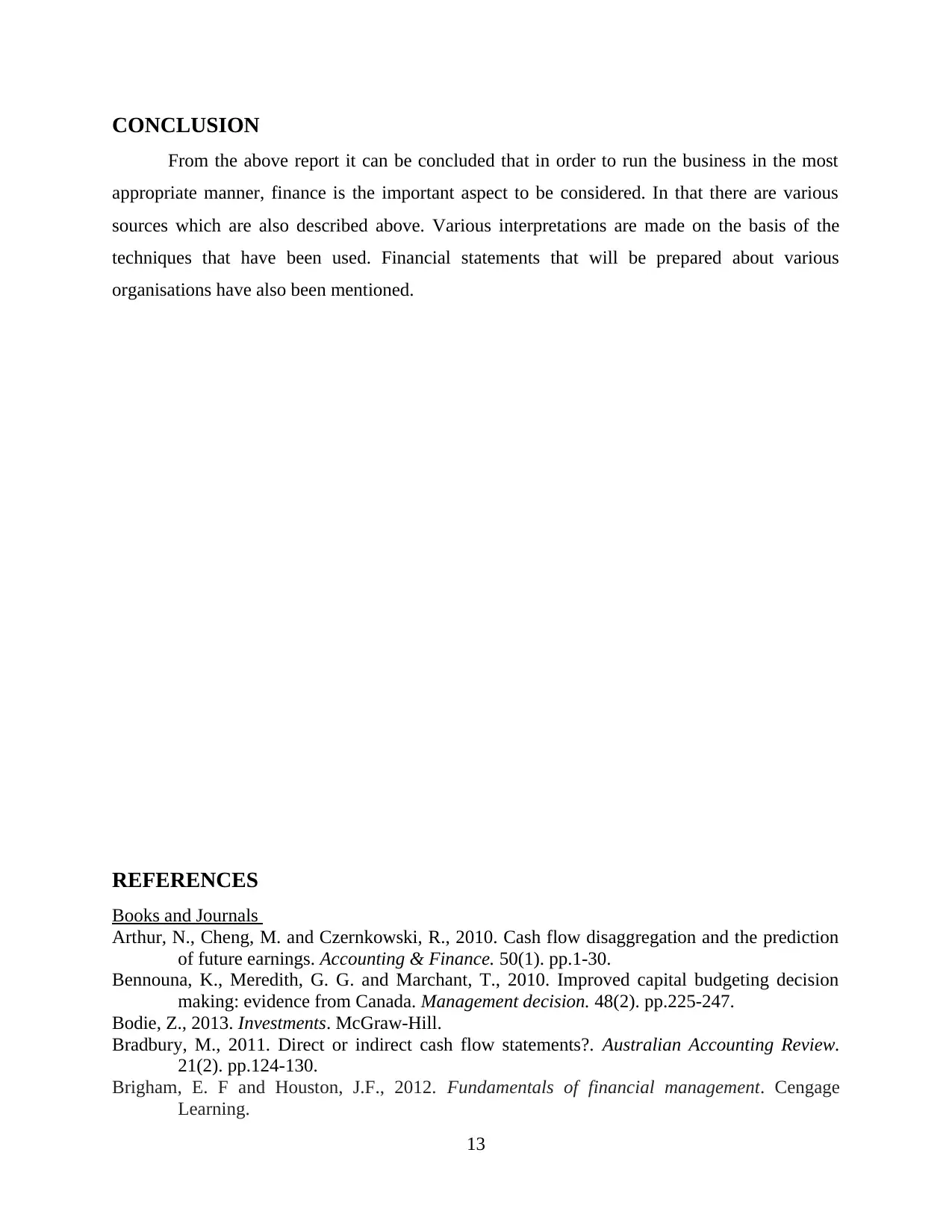
CONCLUSION
From the above report it can be concluded that in order to run the business in the most
appropriate manner, finance is the important aspect to be considered. In that there are various
sources which are also described above. Various interpretations are made on the basis of the
techniques that have been used. Financial statements that will be prepared about various
organisations have also been mentioned.
REFERENCES
Books and Journals
Arthur, N., Cheng, M. and Czernkowski, R., 2010. Cash flow disaggregation and the prediction
of future earnings. Accounting & Finance. 50(1). pp.1-30.
Bennouna, K., Meredith, G. G. and Marchant, T., 2010. Improved capital budgeting decision
making: evidence from Canada. Management decision. 48(2). pp.225-247.
Bodie, Z., 2013. Investments. McGraw-Hill.
Bradbury, M., 2011. Direct or indirect cash flow statements?. Australian Accounting Review.
21(2). pp.124-130.
Brigham, E. F and Houston, J.F., 2012. Fundamentals of financial management. Cengage
Learning.
13
From the above report it can be concluded that in order to run the business in the most
appropriate manner, finance is the important aspect to be considered. In that there are various
sources which are also described above. Various interpretations are made on the basis of the
techniques that have been used. Financial statements that will be prepared about various
organisations have also been mentioned.
REFERENCES
Books and Journals
Arthur, N., Cheng, M. and Czernkowski, R., 2010. Cash flow disaggregation and the prediction
of future earnings. Accounting & Finance. 50(1). pp.1-30.
Bennouna, K., Meredith, G. G. and Marchant, T., 2010. Improved capital budgeting decision
making: evidence from Canada. Management decision. 48(2). pp.225-247.
Bodie, Z., 2013. Investments. McGraw-Hill.
Bradbury, M., 2011. Direct or indirect cash flow statements?. Australian Accounting Review.
21(2). pp.124-130.
Brigham, E. F and Houston, J.F., 2012. Fundamentals of financial management. Cengage
Learning.
13
You're viewing a preview
Unlock full access by subscribing today!
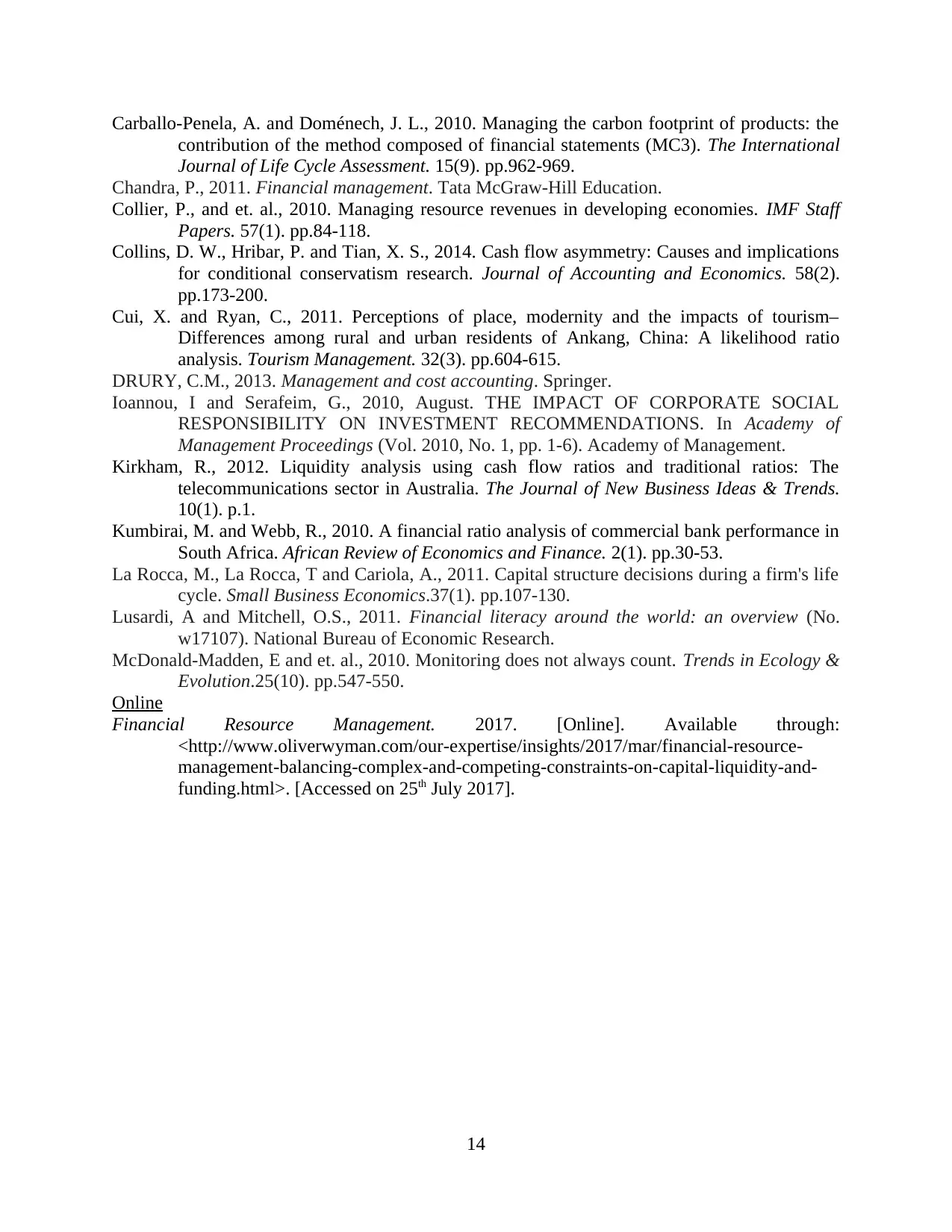
Carballo-Penela, A. and Doménech, J. L., 2010. Managing the carbon footprint of products: the
contribution of the method composed of financial statements (MC3). The International
Journal of Life Cycle Assessment. 15(9). pp.962-969.
Chandra, P., 2011. Financial management. Tata McGraw-Hill Education.
Collier, P., and et. al., 2010. Managing resource revenues in developing economies. IMF Staff
Papers. 57(1). pp.84-118.
Collins, D. W., Hribar, P. and Tian, X. S., 2014. Cash flow asymmetry: Causes and implications
for conditional conservatism research. Journal of Accounting and Economics. 58(2).
pp.173-200.
Cui, X. and Ryan, C., 2011. Perceptions of place, modernity and the impacts of tourism–
Differences among rural and urban residents of Ankang, China: A likelihood ratio
analysis. Tourism Management. 32(3). pp.604-615.
DRURY, C.M., 2013. Management and cost accounting. Springer.
Ioannou, I and Serafeim, G., 2010, August. THE IMPACT OF CORPORATE SOCIAL
RESPONSIBILITY ON INVESTMENT RECOMMENDATIONS. In Academy of
Management Proceedings (Vol. 2010, No. 1, pp. 1-6). Academy of Management.
Kirkham, R., 2012. Liquidity analysis using cash flow ratios and traditional ratios: The
telecommunications sector in Australia. The Journal of New Business Ideas & Trends.
10(1). p.1.
Kumbirai, M. and Webb, R., 2010. A financial ratio analysis of commercial bank performance in
South Africa. African Review of Economics and Finance. 2(1). pp.30-53.
La Rocca, M., La Rocca, T and Cariola, A., 2011. Capital structure decisions during a firm's life
cycle. Small Business Economics.37(1). pp.107-130.
Lusardi, A and Mitchell, O.S., 2011. Financial literacy around the world: an overview (No.
w17107). National Bureau of Economic Research.
McDonald-Madden, E and et. al., 2010. Monitoring does not always count. Trends in Ecology &
Evolution.25(10). pp.547-550.
Online
Financial Resource Management. 2017. [Online]. Available through:
<http://www.oliverwyman.com/our-expertise/insights/2017/mar/financial-resource-
management-balancing-complex-and-competing-constraints-on-capital-liquidity-and-
funding.html>. [Accessed on 25th July 2017].
14
contribution of the method composed of financial statements (MC3). The International
Journal of Life Cycle Assessment. 15(9). pp.962-969.
Chandra, P., 2011. Financial management. Tata McGraw-Hill Education.
Collier, P., and et. al., 2010. Managing resource revenues in developing economies. IMF Staff
Papers. 57(1). pp.84-118.
Collins, D. W., Hribar, P. and Tian, X. S., 2014. Cash flow asymmetry: Causes and implications
for conditional conservatism research. Journal of Accounting and Economics. 58(2).
pp.173-200.
Cui, X. and Ryan, C., 2011. Perceptions of place, modernity and the impacts of tourism–
Differences among rural and urban residents of Ankang, China: A likelihood ratio
analysis. Tourism Management. 32(3). pp.604-615.
DRURY, C.M., 2013. Management and cost accounting. Springer.
Ioannou, I and Serafeim, G., 2010, August. THE IMPACT OF CORPORATE SOCIAL
RESPONSIBILITY ON INVESTMENT RECOMMENDATIONS. In Academy of
Management Proceedings (Vol. 2010, No. 1, pp. 1-6). Academy of Management.
Kirkham, R., 2012. Liquidity analysis using cash flow ratios and traditional ratios: The
telecommunications sector in Australia. The Journal of New Business Ideas & Trends.
10(1). p.1.
Kumbirai, M. and Webb, R., 2010. A financial ratio analysis of commercial bank performance in
South Africa. African Review of Economics and Finance. 2(1). pp.30-53.
La Rocca, M., La Rocca, T and Cariola, A., 2011. Capital structure decisions during a firm's life
cycle. Small Business Economics.37(1). pp.107-130.
Lusardi, A and Mitchell, O.S., 2011. Financial literacy around the world: an overview (No.
w17107). National Bureau of Economic Research.
McDonald-Madden, E and et. al., 2010. Monitoring does not always count. Trends in Ecology &
Evolution.25(10). pp.547-550.
Online
Financial Resource Management. 2017. [Online]. Available through:
<http://www.oliverwyman.com/our-expertise/insights/2017/mar/financial-resource-
management-balancing-complex-and-competing-constraints-on-capital-liquidity-and-
funding.html>. [Accessed on 25th July 2017].
14
1 out of 16
Related Documents
Your All-in-One AI-Powered Toolkit for Academic Success.
+13062052269
info@desklib.com
Available 24*7 on WhatsApp / Email
![[object Object]](/_next/static/media/star-bottom.7253800d.svg)
Unlock your academic potential
© 2024 | Zucol Services PVT LTD | All rights reserved.





